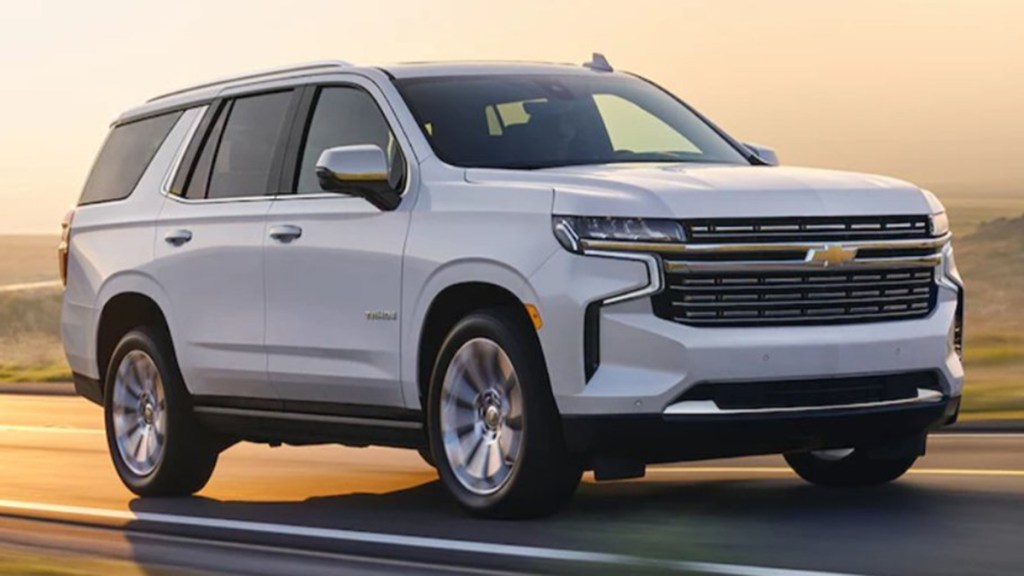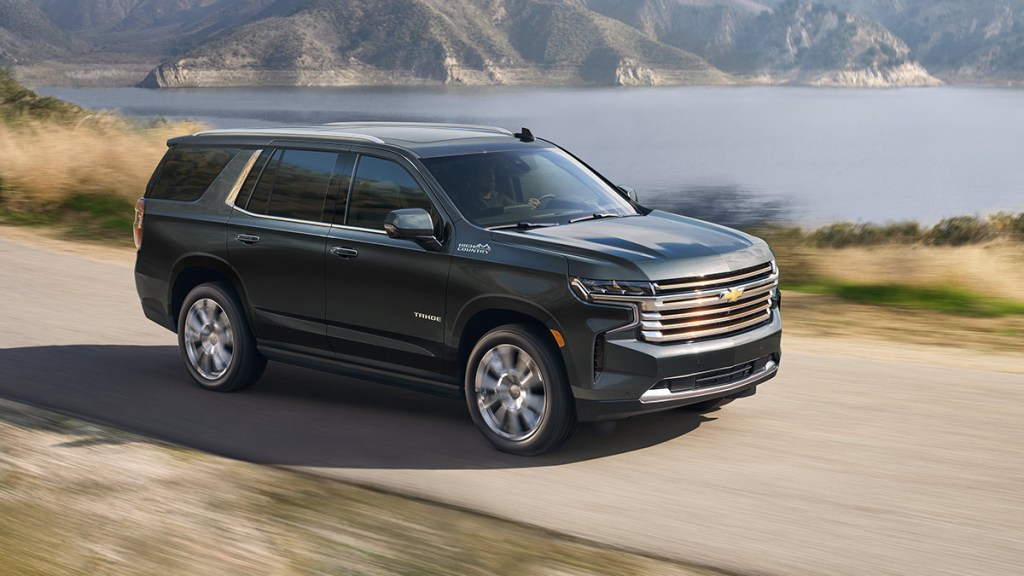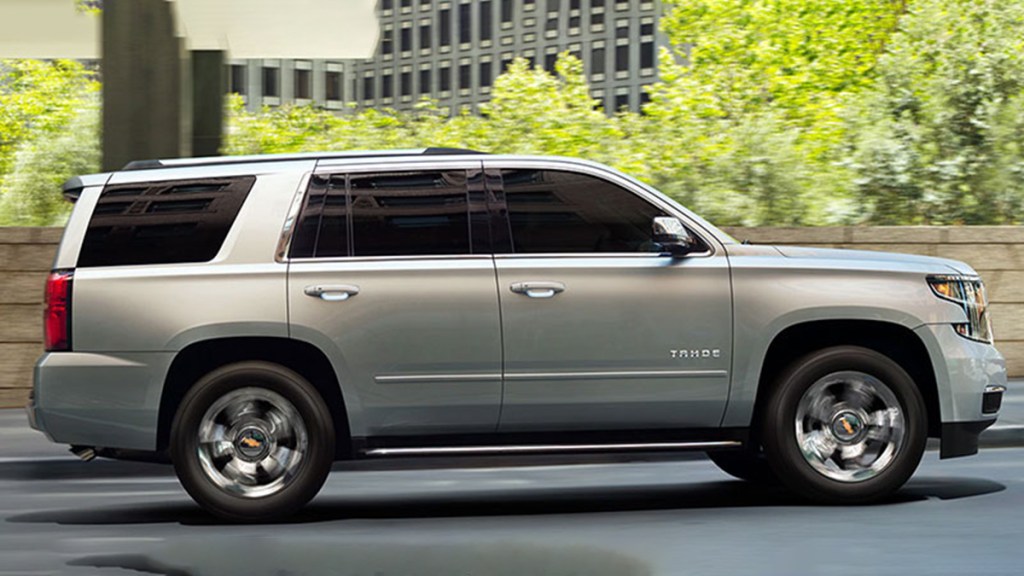Used Chevrolet Tahoe Quick Facts
- The best model years for buying used Chevrolet Tahoe SUVs are from 2021 to 2025. Budget-conscious shoppers might look for a well-maintained 2010-2014 Tahoe.
- Properly equipped, the Tahoe can tow between 6,800 and 8,600 pounds, depending on the trim and year.
- The fifth-generation Tahoe offers a diesel engine option alongside two powerful gas V8s.
Anyone with a big family, big towing needs, or big cargo-hauling requirements likely knows about the Chevrolet Tahoe. This full-size SUV has been moving kids and cargo for three decades, and each generation simply gets better. In many ways, the Chevy Tahoe of today is our parents’ and grandparents’ station wagon of yesteryear. Think about it: A long, body-on-frame wagon with 3-row seating, a powerful V8, and enough muscle to tow the family Airstream up the steepest incline.
Unlike those old wagons, the Tahoe offers greater ground clearance, the option of all-wheel drive (AWD), and advanced safety features designed to keep everyone inside out of harm’s way. Over its many generations, only a few years make our avoid list, with older models proving quite reliable, even with higher mileage.
However, we should note that fuel economy isn’t the Tahoe’s strong point, although the same can be said for all its rivals. If you’re looking for a full-size SUV that can seat up to eight, tow around 8,500 pounds, and is plentiful in the used car market, a previously owned Chevrolet Tahoe makes a great choice.
- What Is the Best Model-Year Used Chevrolet Tahoe?
- Chevrolet Tahoe by Generation: Which Trim Should You Buy?
- Is the Chevrolet Tahoe a Good SUV?
- How Much Can the Chevrolet Tahoe Tow?
- Does the Chevrolet Tahoe Offer a Hybrid Engine?
- Can the Chevrolet Tahoe Go Off-Road?
- What Are the Most Reliable Years for the Chevrolet Tahoe?
- What Are the Least Reliable Years for the Chevrolet Tahoe?
What Is the Best Model-Year Used Chevrolet Tahoe?

We’re of two minds here. If you’ve got money to burn ($40,000 and up), then a fifth-generation 2021 or newer Tahoe is the ideal choice. It’s a modern machine with the latest driver assists and powertrain offerings. And, while there’s no hybrid or electric vehicle (EV) option, a new diesel engine provides better fuel economy and impressive pulling power. As these models were far from inexpensive when new, a used version probably won’t come cheap.
If your budget isn’t flush with Benjamins but you still need a reliable, powerful, and safe SUV, a 2010 through 2014 third-generation Tahoe would be our second choice. It has most of the luxury and tech features of a newer Tahoe, and good marks for reliability and resale.
See used Chevrolet Tahoe SUVs near you.
Chevrolet Tahoe by Generation: Which Should You Buy?
Fifth Generation: 2021-Current

The fifth-generation Chevy Tahoe fixes several shortcomings found in the past, while maintaining the same rugged look and sturdy frame. Under the hood, the familiar 355-horsepower 5.3-liter and 420-hp 6.2-liter V8 engine options remain, accompanied by a new 277-hp 3.0-liter turbodiesel. Under the rear deck, a new independent rear suspension eliminates the annoying raised rear floor from the previous generation, creating a flush, level cargo floor similar to the Ford Expedition.
On the high-tech front, there’s much to like, mainly on the upper trims. Upper trims open the door to features like a digital gauge cluster, adaptive cruise control, and GM’s Super Cruise hands-free semi-autonomous driving assistant (2023 and up).
Chevrolet offers the Tahoe in various trims, each with a style and target audience. The LS and LT trims are the most popular, offering a nice variety of standard and optional equipment at a fair price. The LS features forward collision warning and automatic emergency braking, an 8-way power driver’s seat, tri-zone climate control, a 5.3-liter V8 engine, rain-sensing wipers, a 10-inch infotainment touchscreen, Apple CarPlay, and Android Auto. The LT adds leather upholstery, a hands-free power liftgate, wireless phone charging, heated front seats, and a Bose sound system.
Moving to the RST brings a sportier appearance highlighted by 22-inch wheels and black chrome accents, while the Z71 aims for a more off-road capable attitude, adding standard 4-wheel drive (4WD), skid plate protection, hill descent control, and all-terrain tires.
The cosmopolitan Premier adds polished chrome accents, Magnetic Ride Control, navigation, heated and ventilated 12-way power front seats, and a digital instrument cluster, while the High Country brings a 6.2-liter V8, a head-up display, a digital rearview mirror, a 360-degree monitor, rear pedestrian alert, and a western aesthetic.
A Driver Alert Package for the lower trims adds essentials such as a blind-spot monitor, lane-centering, and rear parking sensors. Upper trims offer lofty upgrades such as air suspension, a panoramic moonroof, and adaptive cruise control.
The Tahoe 2-wheel drive’s tow rating for the 5.3-liter engine maxes out around 8,400 pounds when equipped with the Max Trailer package and 7,900 pounds without it. The 6.2-liter engine drops max towing to 8,300 pounds, and the diesel to 8,200 pounds.
Common issues with this generation revolve around the 5.3-liter’s cylinder deactivation system, which can affect the valve lifters (a common complaint across several generations). Other problems triggered recalls, including daytime running lights that won’t deactivate, and possible engine failure on the 6.2-liter V8 caused by faulty connecting rods. Additional recalls pertain to potential loss of power steering control and improperly secured seat belts.
The National Highway Traffic Safety Administration website provides a complete list of recalls and complaints for any model year Chevrolet Tahoe.
Model-Year Changes
2025: Minor styling updates, a larger digital cluster and touchscreen, and suspension and diesel engine improvements mark the big changes. Base models get more driver assists, such as rear cross-traffic detection and braking, adaptive cruise control, automatic parking assist, and blind-zone steering assist.
2024: No changes.
2023: Super Cruise hands-free driving assistant offered on LT, RST, Premier, and High Country.
2022: A 12-inch digital driver information display becomes standard, while the Premier and High Country offer Enhanced Trailer View and Rear Automatic braking.
See 2021-to-current Chevy Tahoe SUVs near you.
Fourth Generation: 2015-2020

The fourth-generation Tahoe improves upon the third generation with a more rigid frame, more powerful and fuel-efficient engines, and a redesigned interior with better materials and a more upscale look. Unfortunately, this generation also has some of the most problematic years for the Tahoe, with the 2015-2016 models having more complaints and recalls than others.
New standard equipment includes flat-folding second-row and third-row seats and the addition of modern driver assists, like forward collision warning, automatic emergency braking, and lane departure warning. An 8-inch touchscreen infotainment system shows up in the LT and higher trims, adding Apple CarPlay and Android Auto after 2016. Moving up the trim ladder offers features like Magnetic Ride Control, additional safety features, navigation, and ventilated front seats.
The trim line includes the base LS, midlevel LT, and top-line LTZ. Only the 5.3-liter and 6.2-liter V8 carry over from the previous year. The rear-biased 2-wheel drive Tahoe’s max towing capacity is 8,600 pounds.
The fourth-generation Tahoe suffered a series of setbacks, ranging from problem transmissions, a failed air conditioning system due to a cracked condenser, and lifter failures from the cylinder deactivation system (Active Fuel Management or AFM). Early touchscreen systems also suffer some glitches, and there are numerous customer complaints about broken plastic parts, such as the door handles, accessory knobs, and buttons. There are also some reports of excessive oil consumption in the 5.3-liter engine, as well as recalls for upper control arms with insufficient welds, airbags that may not deploy, taillights that fail to operate, and a software error that may cause unintended braking.
Model-Year Changes:
2020: Other than minor package reorganizing, no significant changes exist.
2019: No changes.
2018: A 2-row, 5-passenger LS trim is new, and a new RS trim arrives, offering options like a 6.2-liter V8, Brembo brakes, a Borla exhaust, and a 10-speed automatic transmission.
2017: The LTZ becomes the Premier, Teen Driver joins the equipment roster, and Rear Seat Reminder reminds drivers to check the rear seats before exiting the vehicle.
2016: The LTZ gains a head-up display and an 8-inch configurable display, while the LS offers an Enhanced Driver Alert package with power-adjustable pedals, forward collision alert, lane-keeping, auto high beams, and GM’s Safety Alert Seat.
See 2015-2020 Chevy Tahoe SUVs near you.
Third Generation: 2007-2014

The third-generation Tahoe is a reasonably robust SUV. It holds up well even with higher mileage, suffers from few of the issues found on the fourth-generation model, and offers the broadest range of engines from any Tahoe generation. The standard engine is a 290-hp 4.8-liter V8, with an optional 320-hp 5.3-liter V8 featuring Active Fuel Management cylinder deactivation, which significantly improves highway fuel economy. The Chevy Tahoe Hybrid pairs a 6.0-liter V8 with two 60kW electric motors, resulting in a combined 332 horsepower and EPA estimated 21 mpg in the city and 22 mpg on the highway (20/20 for the 4-wheel drive model). The last optional engine is a 405-horsepower 6.2-liter V8, offered only in 2009 on the LTZ.
The maximum towing weight for the Chevy Tahoe 2WD with the Max Trailering package is 8,200 pounds, while the hybrid is limited to 6,200 pounds.
The third generation is roomy and has many creature comforts, but it does not have advanced driver assistance. It also lacks flush-folding second and third row seats, which must be removed if you need a level load floor.
Offered in three trims (LS, LT, LTZ), buyers of the upper-level models will find things like heated and ventilated front seats, a Bose audio system, a rear-seat DVD entertainment system, side blind-zone alert, and a load-leveling air suspension.
Other than the 2007 model year and the 5.3-liter engine’s lifter issues, most third-generation Tahoe SUVs have few problem areas. Some standouts include an issue with the heated washer nozzle system that could cause a fire (it was recalled and later disabled), rear brake caliper bolts that can fail, and airbags that may fail to deploy in the event of an accident.
Model-Year Changes:
2014: The LS gains power-adjustable pedals, remote start, a rear backup camera, and an inside mirror with camera display.
2013: No major changes.
2012: New features include a navigation radio, trailer sway control, and hill start assist. New features for the LTZ include a blind-spot monitor, heated and cooling front seats, and a heated steering wheel.
2011: The LS gains Bluetooth, rear-seat audio controls, and a luggage rack.
2010: A single-speed transfer case is standard on all 4-wheel-drive models, with a 2-speed case optional.
2009: A 6-speed automatic and a removable third-row seat are made standard. The LTZ offers a 6.2-liter V8, a blind-spot monitor, and Bluetooth.
2008: The Tahoe Hybrid joins the family. Head curtain side airbags are made standard.
See 2007-2014 Chevy Tahoe SUVs near you.
The Early Years: Generations One and Two (1995-2006)
2000-2006: The Second Generation
The second-generation Tahoe isn’t as fun as the first. It drops the 2-door model as well as the beloved 5.7-liter (350) V8. In return, the second-gen Tahoe becomes a more practical family vehicle, with a modern interior and additional safety systems. Popular equipment for this generation includes heated front seats, a power moonroof, Bose audio, power-adjustable pedals, an auto-dimming outside mirror, and OnStar. A third-row seat option increases seating capacity to eight passengers. The standard engine is a 4.8-liter V8 good for 275 hp, with an optional 5.3-liter V8 putting out 285 hp. Other improvements included a new suspension for a more comfortable ride and better handling.
Chevy made numerous changes to the Tahoe during this time, so here are a few helpful notes if you’re looking for specific features. In 2002, the Tahoe LS gained standard heated mirrors, driver and passenger side power seats, rear heating, an upgraded suspension, and a rear defroster. The 2003 Tahoe sees a slight makeover along with available StabiliTrak electronic stability control, a Bose audio system, electronic climate control, power-adjustable pedals, and satellite radio. For 2004, the 5.3-liter V8’s output rose to 295 hp, and in 2005, StabiliTrak and a 2-piece rear liftgate were made standard. Like the first generation, these models have a good reputation for longevity, but with expected repairs that can sometimes be costly.
See 2000-2006 Chevy Tahoe SUVs near you.
1995-1999: The First Generation
Chevrolet debuted the Tahoe in 1995, riding atop a shortened Suburban platform. Buyers could opt for models with two or four doors, running a 5.7-liter V8 or, on the 2-door models, a 6.5-liter turbodiesel. You could even get a 5-speed manual on the 2-door 4-wheel-drive models, but only in the first year of production.
The first-gen Tahoe’s standard safety equipment is on the light side by today’s standards, but does include a driver’s side airbag and antilock disc brakes. Power comes from a 5.7-liter V8, good for 250 hp. A full-time 4-wheel-drive system shows up in 1998. Trim levels include the LS and LT, with two special edition models (Limited and Z71) running as carryovers into the 2000 model year.
See 1995-1999 Chevy Tahoe SUVs near you.
Is the Chevrolet Tahoe a Good SUV?
For most of its existence, the Chevy Tahoe has been a good SUV. While not as bulletproof as a Toyota Land Cruiser or Sequoia, it’s not far off. The second, third, and fifth generations have the fewest issues. While the fourth generation has its share of problems, they are limited to a few years and not the entire model run. To ensure a solid Chevy Tahoe, look for a certified pre-owned (CPO) vehicle where available. CPO vehicles are manufacturer-certified with multipoint inspections and additional warranties, making them worth the extra cost involved.
See certified pre-owned Chevy Tahoe SUVs for sale near you.
How Much Can the Chevrolet Tahoe Tow?
The maximum tow rating on the fifth generation is 8,400 pounds, the fourth generation is 8,600 pounds, and the third generation is 8,200 pounds (not including the hybrid). These figures require the Max Trailering package. Without it, the figures drop into the 7,500-to-7,900-pound range, depending on the year.
Does the Chevrolet Tahoe Offer a Hybrid Engine?
The third-generation Tahoe offers the option of Two-Mode Hybrid technology. It pairs a 6.0-liter gas V8 engine with twin electric motors, helping the SUV achieve a combined 21 mpg.
Can the Chevrolet Tahoe Go Off-Road?
The Tahoe has plenty of ground clearance and a sturdy body-on-frame chassis, making it well equipped for off-road use. However, if you plan on taking your Tahoe to places with more than dirt roads and a few bumps, you’ll want one with the Z71 package.
What Are the Most Reliable Years for the Chevrolet Tahoe?
For the fifth-generation SUV, we like 2022 and newer. For the fourth-generation SUV, we’d say 2018-2020, and for the third-generation SUV, just about any year save for 2007.
What Are the Least Reliable Years for the Chevrolet Tahoe?
The years with the most issues seem to be 2007, 2014-2017, and 2020. Some of the 5.3-liter V8s with cylinder deactivation can run rough or shudder as the system kicks on and off. Others have found the system can lead to excessive oil consumption, problems with the lifters, and even the need to rebuild the engine’s entire top end. The lifters are responsible for opening and closing the valves, and when they go bad, symptoms can range from a ticking or chirping noise to a rough idle, misfires, and reduced fuel economy. The system can either be repaired or disabled; either way, it can be a costly repair. Other sporadic complaints found on various consumer sites include a leaking sunroof, cheap plastic bits inside the cabin that break over time, and some minor electrical issues with interior components and engine sensors.











